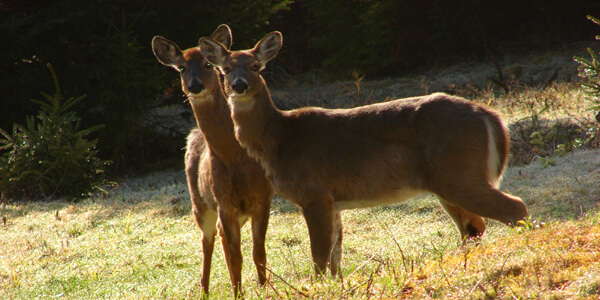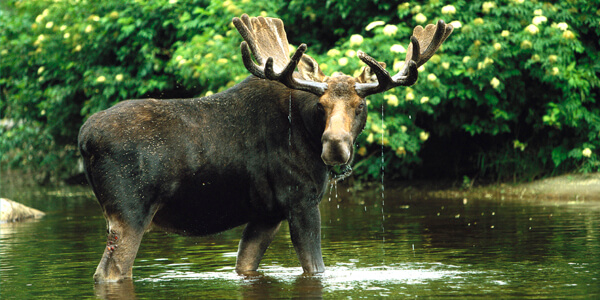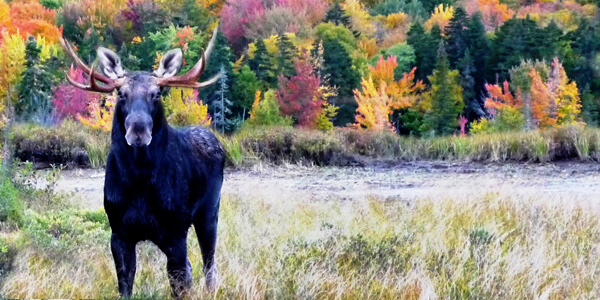Embark on a Wildlife Odyssey in Rangeley, Maine
In the enchanting wilderness of Rangeley, Maine, a world of wildlife wonders awaits. From the majestic moose, the largest member of the deer family, to the charming common loon with its striking black-and-white plumage, every moment is a snapshot of nature's beauty. Wildlife viewing is not limited to moose and loons - be on the lookout for everything from bald eagles, deer, foxes, black bears and bobcats to loons calling on the lakes can be found in the vast wilderness of the Rangeley Lakes Region!
Moose Marvels
Spotting a moose in the Rangeley Lakes region is like discovering a hidden treasure. Whether you're captivated by the antics of gangly moose calves (often seen in playful pairs) or marveling at the grandeur of mature bull moose with impressive racks, it's a treat for every visitor. Keep your camera ready for the chance to capture Maine's official state animal in its natural habitat. To increase your chances of moose sightings, plan your wildlife adventure during late spring to mid-summer and the month of September. Early morning and evening (dawn and dusk) are prime times for spotting these gentle giants as they graze on woodland and aquatic vegetation.
Moose Manners
While moose may have poor eyesight, they compensate with keen hearing and smell. Exercise caution, especially around cows with calves and bulls during "Rutting Season" – a charged encounter is not on any tourist's agenda! For an expert-guided moose safari, book a few hours with one of Rangeley's Registered Maine guides.
Loon Serenade
The common loon, adorned in distinctive black-and-white breeding plumage with striking red eyes, graces the lakes with its elegance. Watch as they gracefully dive for fish, and if you're lucky, catch a heartwarming glimpse of loon chicks hitching a ride on their parents' backs. The lakes come alive with the enchanting calls of loons echoing through the wilderness.
Give ‘em space: Observe Nesting Loons from a Distance nesting loons and loons with babies lots of distance we recommend a distance of 150 feet or more, when possible. Loons' bodies are designed for life in the water, and as a result, they cannot walk well on land. When on land to nest, a loon's lack of mobility makes it vulnerable to predators and other threats. For more information refer to this guide How Close is Too Close by Maine Audubon.
Beyond Moose and Loons
Wildlife viewing in Rangeley extends far beyond moose and loons. Keep your eyes peeled for the regal bald eagles, elusive deer, playful foxes, majestic black bears, and elusive bobcats. The vast wilderness of the Rangeley Lakes Region is a canvas painted with the diverse hues of nature's inhabitants.
Embark on a journey into the heart of Rangeley's wilderness, where every rustle of leaves and ripple in the water unveils a new chapter in the captivating story of Maine's wildlife.
Moose Watching Hot Spots
Rangeley – Oquossoc, Maine Area
Route 16: Rangeley to Stratton – Several spots along this route, ask locally for recent sightings.
Route 16: Rangeley/Oquossoc to Wilson’s Mills – Sightings near Wilson’s Mills to New Hampshire border.
Route 17: Rangeley/Oquossoc to Rumford – Between Rangeley Scenic Overlook & Height of Land.
Phillips – Weld, Maine Area
Route 4: Phillips to Rangeley – Several spots along this route, ask locally for recent sightings.
Route 142: Between Phillips and Weld. Several spots along this route, ask locally for recent sightings.
Stratton – Eustis, Maine Area
Route 27: Between Eustis and the Chain of Ponds. Several spots along this route, ask locally for recent sightings.




